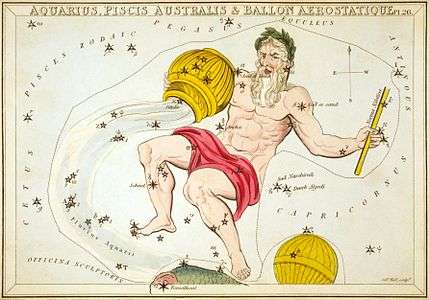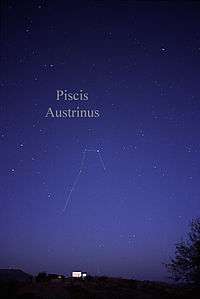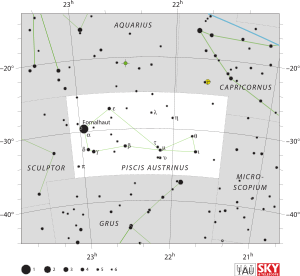Piscis Austrinus
| Constellation | |
|
| |
| Abbreviation | PsA |
|---|---|
| Genitive | Piscis Austrini |
| Pronunciation | /ˈpaɪsᵻs ɒsˈtraɪnəs/ or /ɒsˈtreɪlᵻs/, genitive /ˈpaɪsᵻs ɒˈstraɪnaɪ/ |
| Symbolism | the Southern Fish |
| Right ascension | 22 |
| Declination | −30 |
| Family | Heavenly Waters |
| Quadrant | SQ4 |
| Area | 245 sq. deg. (60th) |
| Main stars | 7 |
| Bayer/Flamsteed stars | 21 |
| Stars with planets | 3 |
| Stars brighter than 3.00m | 1 |
| Stars within 10.00 pc (32.62 ly) | 3 |
| Brightest star | Fomalhaut (α PsA) (1.16m) |
| Nearest star |
Lacaille 9352 (10.74 ly, 3.29 pc) |
| Messier objects | 0 |
| Meteor showers | ? |
| Bordering constellations |
Capricornus Microscopium Grus Sculptor Aquarius |
|
Visible at latitudes between +55° and −90°. Best visible at 21:00 (9 p.m.) during the month of October. | |
Piscis Austrinus (also known as Piscis Australis) is a constellation in the southern celestial hemisphere. The name is Latin for "the southern fish", in contrast with the larger constellation Pisces, which represents a pair of fishes. Prior to the 20th century, it was also known as Piscis Notius. Its only star brighter than fourth magnitude is Fomalhaut, which is a first-magnitude star and is the eighteenth-brightest star in the night sky.
Piscis Austrinus was one of the 48 constellations listed by the 2nd-century astronomer Ptolemy, and it remains one of the 88 modern constellations. The stars of the modern constellation Grus once formed the "tail" of Piscis Austrinus. In 1597 (or 1598), Petrus Plancius carved out a separate constellation and named it after the crane.

In Greek mythology, this constellation is known as the Great Fish and it is portrayed as swallowing the water being poured out by Aquarius, the water-bearer constellation. The two fish of the constellation Pisces are said to be the offspring of the Great Fish. In Egyptian mythology, this fish saved the life of the Egyptian goddess Isis, so she placed this fish and its descendants into the heavens as constellations of stars.[1]
Origins
Pisces Austrinus originated with the Babylonian constellation simply known as the Fish (MUL.KU). Professor of astronomy Bradley Schaefer has proposed that ancient observers must have been able to see as far south as Mu Piscis Austrini to define a pattern that looked like an fish.[2]
Characteristics
Piscis Austrinus is a constellation bordered by Capricornus to the northwest, Microscopium to the southwest, Grus to the south, Sculptor to the east, Aquarius to the north. The recommended three-letter abbreviation for the constellation, as adopted by the International Astronomical Union in 1922, is 'PsA'.[3] The official constellation boundaries, as set by Eugène Delporte in 1930, are defined by a polygon of four segments. In the equatorial coordinate system, the right ascension coordinates of these borders lie between 21h 27.3m and 23h 06.5m, while the declination coordinates are between -24.83° and -36.46°.[4]
Notable features

Fomalhaut traditionally represents the mouth of the fish. Its companion Fomalhaut b was thought to be the first extrasolar planet ever detected by a visible light image, thanks to the Hubble Space Telescope, but infrared observations have since retracted this claim: it is instead a spherical cloud of dust. TW Piscis Austrini can be seen close by and is possibly associated with Fomalhaut as it lies within a light-year of it. Of magnitude 6.5, it is a BY Draconis variable.[5]
Beta, Delta and Zeta constitute the Tien Kang ("heavenly rope") in China.[6] Beta is a white star of apparent magnitude 4.29 and spectral type A0, and lies 130 light-years away.[7] Delta Piscis Austrini is a double star with components of magnitude 4.2 and 9.2.[5]
S Piscis Austrini is a long-period Mira-type variable red giant which ranges between magnitude 8.0 and 14.5 over a period of 271.7 days, and V Piscis Austrini is a semi-regular variable ranging between magnitudes 8.0 and 9.0 over 148 days.[5]
Lacaille 9352 is a faint red dwarf star which is a mere 10.74 light-years away. At magnitude 7.34, it is too dim to be seen with the naked eye.
NGC 7172, NGC 7174 and NGC 7314 are three galaxies of magnitudes 11.9, 12.5 and 10.9, respectively.[5]
References
- ↑ Eratosthenes; Hyginus, C. Julius (1997). Star myths of the Greeks and Romans: a sourcebook containing the Constellations of Pseudo-Eratosthenes and the Poetic astronomy of Hyginus. Translated by Condos, Theony. Red Wheel/Weiser. pp. 163–164. ISBN 1-890482-93-5.
- ↑ Schaefer, Bradley E. (2002). "The latitude and epoch for the formation of the southern Greek constellations". Journal for the History of Astronomy. 33 (113): 313–50. Bibcode:2002JHA....33..313S. ISSN 0021-8286. Unknown parameter
|Part=ignored (help) - ↑ Russell, Henry Norris (1922). "The new international symbols for the constellations". Popular Astronomy. 30: 469. Bibcode:1922PA.....30..469R.
- ↑ "Piscis Austrinus, constellation boundary". The Constellations. International Astronomical Union. Retrieved 20 August 2012.
- 1 2 3 4 Moore, Patrick (2011). Patrick Moore's Data Book of Astronomy. Cambridge University Press. p. 472. ISBN 0521899354.
- ↑ Richard Hinckley Allen: Star Names — Their Lore and Meaning: Piscis Australis, the Southern Fish
- ↑ Kaler, Jim (12 November 2009). "Beta PsA".
- Ian Ridpath and Wil Tirion (2007). Stars and Planets Guide, Collins, London. ISBN 978-0-00-725120-9. Princeton University Press, Princeton. ISBN 978-0-691-13556-4.
External links
| Wikimedia Commons has media related to: |
- The Deep Photographic Guide to the Constellations: Piscis Austrinus
- Star Tales – Piscis Austrinus
- Piscis Austrinus at Constellation Guide
- Warburg Institute Iconographic Database (over 150 medieval and early modern images of Piscis Austrinus - Piscis magnus)
Coordinates: ![]() 22h 00m 00s, −30° 00′ 00″
22h 00m 00s, −30° 00′ 00″
